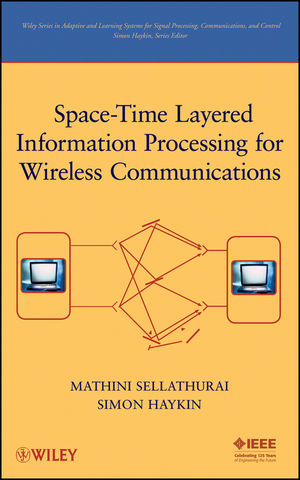Space-Time Layered Information Processing for Wireless CommunicationsISBN: 978-0-471-20921-8
Hardcover
220 pages
April 2009, Wiley-IEEE Press
 |
||||||
List of Tables.
List of Figures.
1 Introduction.
1.1 Brief Historical Notes.
1.2 Turbo-Information Processing.
1.3 MIMO Wireless Communications.
1.4 Organization of the Book.
2 MIMO Channel Capacity.
2.1 Introduction.
2.2 Multiple-Input, Multiple-Output Antenna Systems.
2.3 Channel Capacity.
2.4 MIMO Capacity for a Channel Known at the Receiver.
2.5 Channel Known at the Transmitter.
2.6 Summary and Discussion.
3 BLAST Architectures.
3.1 BLAST Architecture.
3.2 Diagonal BLAST.
3.3 Vertical BLAST (V-BLAST).
3.4 Stratified Diagonal BLAST (SD-BLAST).
3.5 Simulations on BLAST for the Matrix Rayleigh Channel.
3.6 Multirate Layered Space-Time Architecture.
3.7 Outage Capacity.
3.8 Simulation Results.
3.9 Summary and Discussion.
4 Space-Time Turbo Codes and Turbo Decoding Principles.
4.1 Introduction.
4.2 Turbo Codes.
4.3 Interleaver Designs for Turbo Codes.
4.4 Space-Time Turbo Codes.
4.4.1 Example Space-Time Turbo Codes.
4.5 Multirate Layered Space-Time (MLST) Turbo Codes.
4.6 Summary and Discussion.
5 Turbo-BLAST.
5.1 Introduction.
5.2 T-BLAST: Basic Transmitter Considerations.
5.3 Optimal Detection.
5.4 Distance Spectrum of RLST Codes.
5.5 Iterative Decoding: Basic Considerations.
5.6 Design and Performance of SISO Detectors.
5.7 Simulations on T-BLAST.
5.8 Summary and Discussion.
5.9 Appendix.
6 Turbo-MIMO Systems.
6.1 Bit-Interleaved Coded Modulation.
6.2 Turbo-MIMO Theory and ST-BICM.
6.3 ST-BICM.
6.4 Iterative Detection and Decoding.
6.5 Suboptimal MIMO Detection.
6.6 Simulation for Narrowband Turbo-MIMO.
6.7 Wideband Turbo-MIMO (ST-BICM).
6.8 Summary.
Appendix 6.1.
Appendix 6.2.
Bibliography.
Index.
List of Figures.
1 Introduction.
1.1 Brief Historical Notes.
1.2 Turbo-Information Processing.
1.3 MIMO Wireless Communications.
1.4 Organization of the Book.
2 MIMO Channel Capacity.
2.1 Introduction.
2.2 Multiple-Input, Multiple-Output Antenna Systems.
2.3 Channel Capacity.
2.4 MIMO Capacity for a Channel Known at the Receiver.
2.5 Channel Known at the Transmitter.
2.6 Summary and Discussion.
3 BLAST Architectures.
3.1 BLAST Architecture.
3.2 Diagonal BLAST.
3.3 Vertical BLAST (V-BLAST).
3.4 Stratified Diagonal BLAST (SD-BLAST).
3.5 Simulations on BLAST for the Matrix Rayleigh Channel.
3.6 Multirate Layered Space-Time Architecture.
3.7 Outage Capacity.
3.8 Simulation Results.
3.9 Summary and Discussion.
4 Space-Time Turbo Codes and Turbo Decoding Principles.
4.1 Introduction.
4.2 Turbo Codes.
4.3 Interleaver Designs for Turbo Codes.
4.4 Space-Time Turbo Codes.
4.4.1 Example Space-Time Turbo Codes.
4.5 Multirate Layered Space-Time (MLST) Turbo Codes.
4.6 Summary and Discussion.
5 Turbo-BLAST.
5.1 Introduction.
5.2 T-BLAST: Basic Transmitter Considerations.
5.3 Optimal Detection.
5.4 Distance Spectrum of RLST Codes.
5.5 Iterative Decoding: Basic Considerations.
5.6 Design and Performance of SISO Detectors.
5.7 Simulations on T-BLAST.
5.8 Summary and Discussion.
5.9 Appendix.
6 Turbo-MIMO Systems.
6.1 Bit-Interleaved Coded Modulation.
6.2 Turbo-MIMO Theory and ST-BICM.
6.3 ST-BICM.
6.4 Iterative Detection and Decoding.
6.5 Suboptimal MIMO Detection.
6.6 Simulation for Narrowband Turbo-MIMO.
6.7 Wideband Turbo-MIMO (ST-BICM).
6.8 Summary.
Appendix 6.1.
Appendix 6.2.
Bibliography.
Index.



